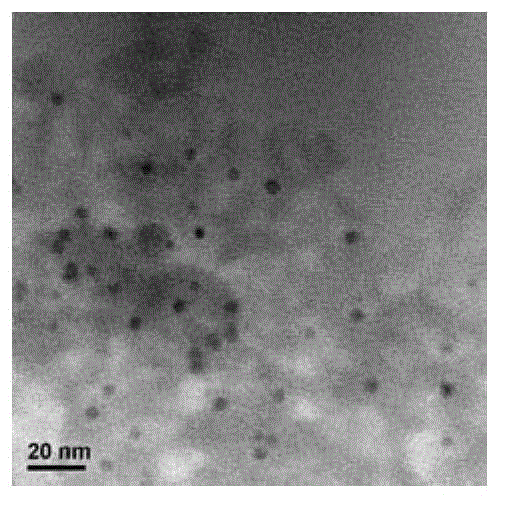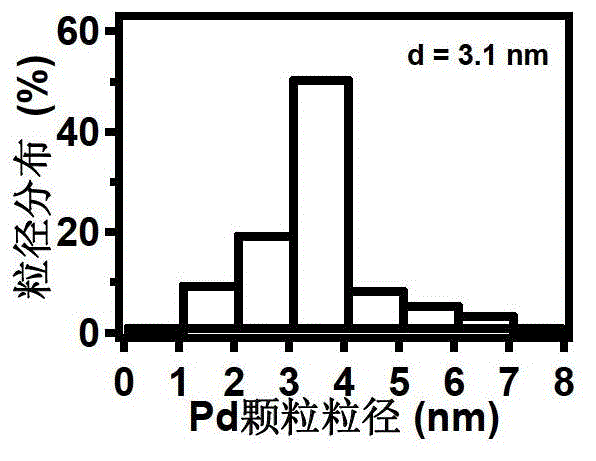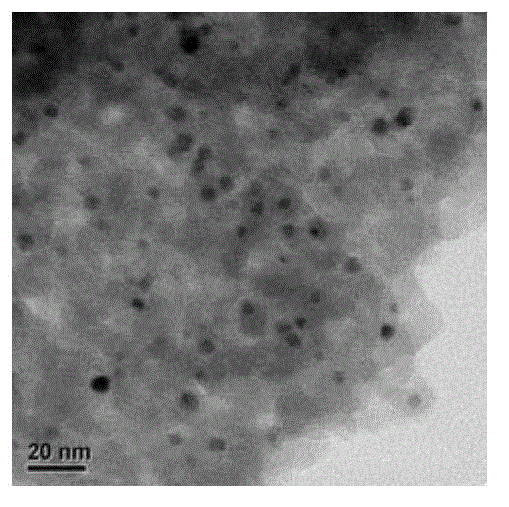Sintering-resisting loading type nanometer palladium catalyst and preparing method and application thereof
A supported catalyst technology, which is applied in the field of anti-sintering nano-Pd catalysts, can solve the problems of industrial application limitations, long preparation cycle, cumbersome preparation process, etc., and achieve improved anti-sintering performance, excellent CO ignition performance, and improved dispersion. Effect
- Summary
- Abstract
- Description
- Claims
- Application Information
AI Technical Summary
Problems solved by technology
Method used
Image
Examples
Embodiment 1
[0026] Weigh 10g SiO 2 Carrier (Aldrich Chemical Company, 35~60 mesh), soaked in 20% dilute nitric acid solution for 24h, stirred 3~5 times during the period, then washed with distilled water to pH=7.0, dried at 110°C for 12h, and set aside. 2g of processed SiO 2 Immerse in 6ml of Pd with a mass concentration of 1.04mg / ml for 24h, then dry at 110°C for 12h, roast at 800°C in air for 2h, the heating rate is 10°C / min, and 600°C in high-purity hydrogen C reduced for 0.5h to get 3wt%Pd / SiO 2 -800-Air catalyst, denoted as Cat 1, the particle size of Pd particles is 3.1nm, see figure 1 and 2 .
[0027] Take by weighing 10mg above-mentioned catalyst Cat 1 and pack in the micro-fixed-bed flow reactor, catalyst first in high-purity H 2 Heat up to 600°C at a rate of 20°C / min in the gas stream, reduce for 30 minutes, cool down to room temperature, switch to high-purity He for about 20 minutes, and then switch to CO / O 2 / He (1 / 1 / 98, volume ratio) reaction gas for heating reaction, t...
Embodiment 2
[0035] Implementation steps and conditions are the same as embodiment 1, but catalyst roasting atmosphere is changed into N by air 2 , to get 3wt%Pd / SiO 2 -800-N 2 Catalyst, denoted as Cat 2, the particle size of Pd particles is 3.8nm, see Figure 5 and 6 , and its CO oxidation reaction performance results are shown in Table 1.
Embodiment 3
[0039] Implementation steps and conditions are the same as in Example 1, except that the solvent acetylacetone used as palladium acetylacetonate is changed to toluene to obtain 3wt%Pd / SiO 2 -800-Air-2 catalyst, denoted as Cat 3, the particle size of Pd particles is 3.1nm, and its CO oxidation reaction performance results are shown in Table 1.
PUM
| Property | Measurement | Unit |
|---|---|---|
| Particle size | aaaaa | aaaaa |
| Particle size | aaaaa | aaaaa |
| Particle size | aaaaa | aaaaa |
Abstract
Description
Claims
Application Information
 Login to View More
Login to View More - R&D
- Intellectual Property
- Life Sciences
- Materials
- Tech Scout
- Unparalleled Data Quality
- Higher Quality Content
- 60% Fewer Hallucinations
Browse by: Latest US Patents, China's latest patents, Technical Efficacy Thesaurus, Application Domain, Technology Topic, Popular Technical Reports.
© 2025 PatSnap. All rights reserved.Legal|Privacy policy|Modern Slavery Act Transparency Statement|Sitemap|About US| Contact US: help@patsnap.com



